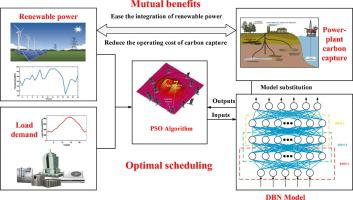Energy Conversion and Management ( IF 9.9 ) Pub Date : 2021-02-20 , DOI: 10.1016/j.enconman.2021.113856 Xianhao Chen , Xiao Wu , Kwang Y. Lee

|
Renewable power and carbon capture are key technologies to transfer the power industry into low carbon generation. Renewables have been developed fast, however, the intermittent nature has imposed higher requirement for the flexibility of the power grid. Retrofitting carbon capture technologies to existing fossil-fuel fired power plants is an important solution to avoid the “lock-in” of emissions, but the high operating costs hinders their large scale application. The coexistence of renewable power and carbon capture opens up a new avenue that the deployment of carbon capture can provide additional flexibility for better accommodation of renewable power while excess renewables can be used to reduce the operating costs of carbon capture. To this end, this paper proposes an artificial intelligence based optimal scheduling strategy for the power plant-carbon capture system in the context of renewable power penetration to show that the mutual benefits between carbon capture and renewable power can be achieved when the carbon capture process is made fully adjustable. An artificial intelligent deep belief neural network is used to reflect the complex interactions between carbon, heat and electricity within the power plant carbon capture system. Multiple operating goals are considered in the scheduling such as minimizing the operating costs, renewable power curtailment and carbon emission, and the particle swarm heuristic optimization is employed to find the optimal solution. The impacts of carbon capture constraint mode, carbon emission penalty coefficient, carbon dioxide production constraints and renewable power installed capacity are investigated to provide broader insight on the potential benefit of carbon capture in future low-carbon energy system. A case study using real world data of weather condition and load demand shows that renewable power curtailment can be reduced by 51% with the integration of post-combustion capture systems and 35% of total carbon emission are captured by the use of excess renewable power through optimal scheduling. This paper points out a new way of using artificial intelligent technologies to coordinate the couplings between carbon and electricity for efficient and environmentally friendly operation of future low-carbon energy system.
中文翻译:

可再生能源和碳捕集的共同利益:通过人工智能调度策略实现
可再生能源发电和碳捕集是将电力行业转变为低碳发电的关键技术。可再生能源的发展很快,但是,间歇性对电网的灵活性提出了更高的要求。在现有的化石燃料发电厂中改造碳捕集技术是避免排放“锁定”的重要解决方案,但是高昂的运营成本阻碍了它们的大规模应用。可再生能源与碳捕集的共存开辟了一条新途径,即碳捕集的部署可以提供更多的灵活性,以更好地容纳可再生能源,同时可以使用过量的可再生能源来降低碳捕集的运营成本。为此,本文针对可再生能源渗透的背景,提出了一种基于人工智能的电厂-碳捕集系统最优调度策略,以表明当碳捕集过程完全可调时,可以实现碳捕集与可再生能源之间的共同利益。人工智能深度信念神经网络用于反映电厂碳捕获系统中碳,热和电之间的复杂相互作用。在调度中考虑了多个操作目标,例如最小化操作成本,减少可再生能源消耗和碳排放,并采用粒子群启发式优化来找到最佳解决方案。碳捕集约束方式,碳排放惩罚系数,对二氧化碳的生产限制和可再生能源的装机容量进行了研究,以提供有关碳捕集在未来低碳能源系统中的潜在利益的更广泛的见解。使用现实世界的天气状况和负荷需求数据进行的案例研究表明,通过集成燃烧后捕集系统,可再生能源的削减量可减少51%,而通过使用过量的可再生能源可捕获35%的总碳排放量最佳调度。本文指出了一种使用人工智能技术来协调碳和电之间的耦合的新方法,以使未来的低碳能源系统高效,环保地运行。









































 京公网安备 11010802027423号
京公网安备 11010802027423号